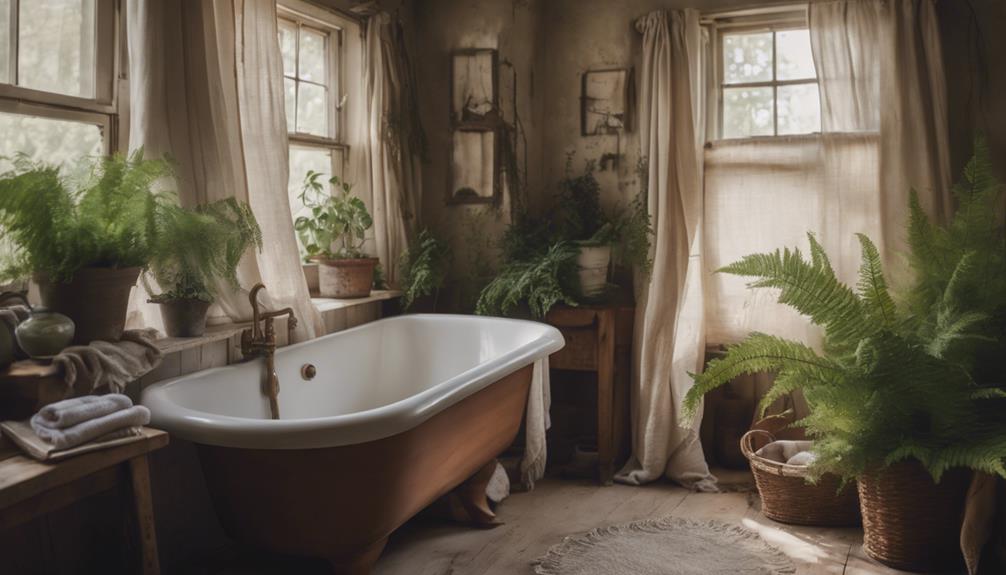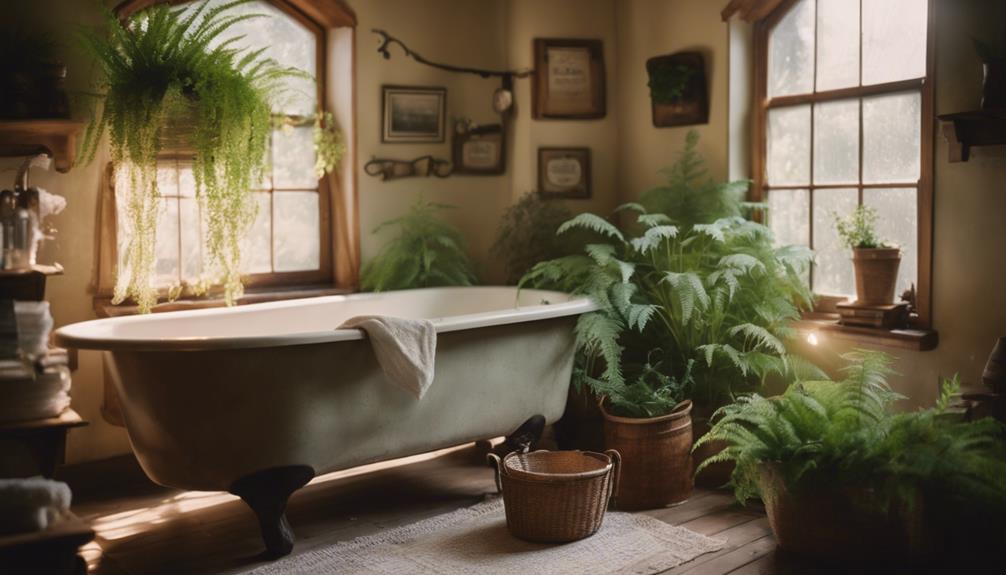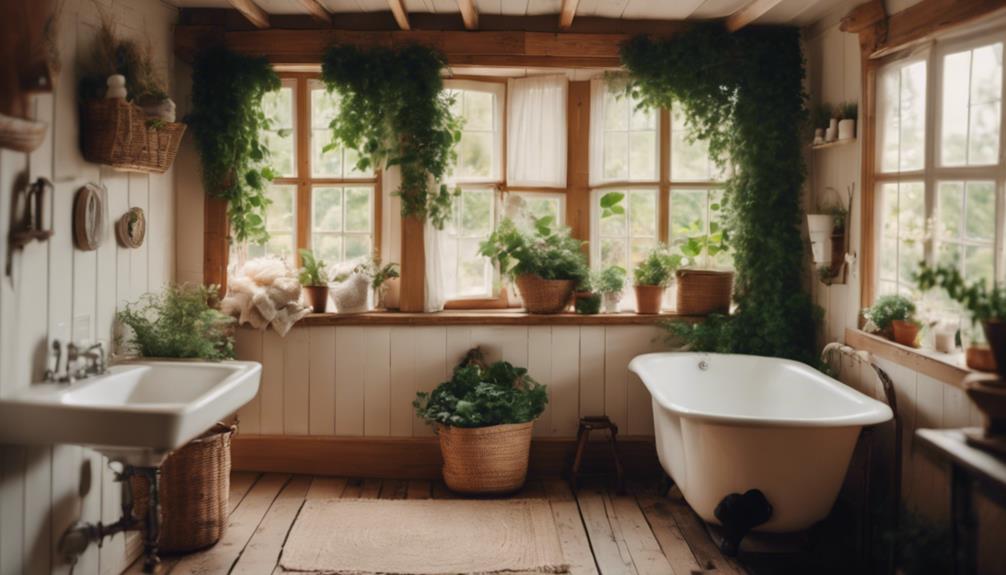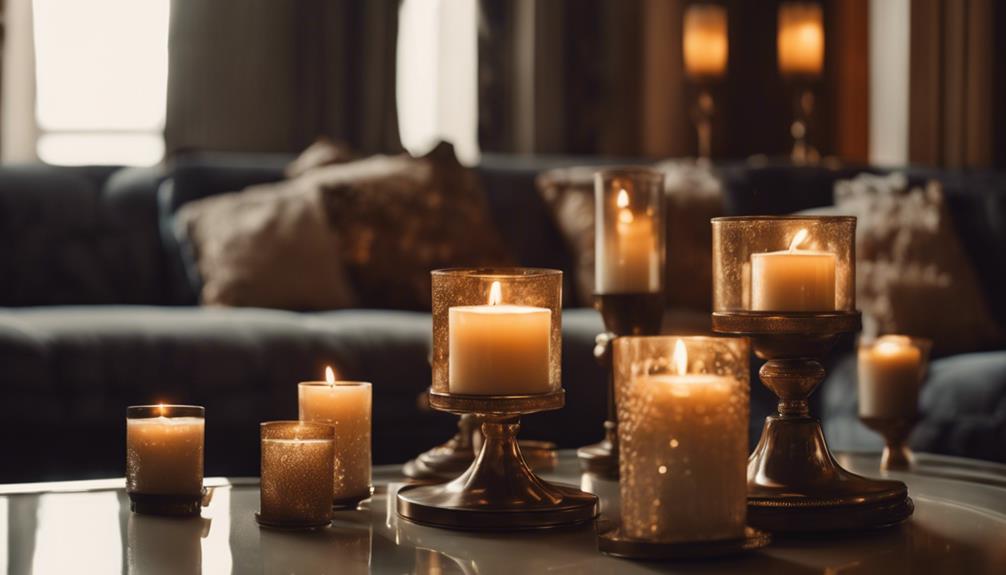You can transform your bathroom into a cozy cottagecore retreat by adding natural elements in just one weekend. Start with a soft, earthy color palette featuring pastel shades. Incorporate vintage fixtures like a porcelain sink and brass faucet to enhance rustic charm. Use natural materials such as wood and wicker for warmth. Soft textiles in cotton or linen invite comfort, while floral prints bring whimsy. Opt for vintage-inspired lighting, like antique sconces or fairy lights, to create a warm ambiance. With these touches, your space will feel inviting. There's so much more to explore about achieving this enchanting aesthetic.
Key Elements

When you're creating your cottagecore bathroom, the right color scheme, materials, and textures play an essential role.
You'll want to choose soft, earthy tones that bring a sense of calm, while incorporating natural elements like wood and stone.
These key elements work together to cultivate a cozy, rustic vibe that invites relaxation.
Color Scheme
A cottagecore bathroom embraces a soft color palette, featuring pastel shades like light blue, blush pink, and creamy whites that create a calming atmosphere. These colors not only evoke tranquility but also make the space feel larger and more inviting.
To enhance the natural feel of your bathroom, consider incorporating earthy tones, such as sage green, terracotta, and muted browns. These hues foster a serene connection to the outdoors, grounding your space in nature.
Floral patterns can also play a significant role in your color scheme. Whether you use floral wallpaper or textiles, they add visual interest and whimsy, reinforcing the nostalgic elements of the cottagecore aesthetic. When you combine light and earthy tones, you create a harmonious balance that feels both fresh and inviting.
Don't forget the importance of texture in your color scheme. Mixing smooth finishes, like polished ceramic fixtures, with rustic wood accents adds dimension and warmth. This thoughtful combination of colors and textures will transform your bathroom into a cozy retreat, perfectly capturing the essence of cottagecore style.
Materials
Incorporating natural materials like wood, stone, and wicker instantly enhances the warmth and texture of your cottagecore bathroom, creating an inviting atmosphere.
To achieve that earthy, rustic charm, consider using vintage fixtures made from brass or copper. These elements don't just add character; they fit seamlessly into the overall cottagecore aesthetic.
For flooring, pastel-colored tiles or natural stone create a calming ambiance while maintaining those essential natural textures. Woven baskets can serve as stylish storage solutions, combining functionality with a cozy aesthetic. They complement the emphasis on organization and natural elements that define cottagecore style.
Choose soft textiles made from cotton or linen for towels and shower curtains. These materials not only add comfort but also help maintain the serene vibe of your bathroom.
Textures
Textures play an essential role in defining the cozy, inviting atmosphere of your cottagecore bathroom, blending the softness of textiles with the ruggedness of natural materials. To achieve this aesthetic, incorporate elements like wood, stone, and wicker. A wooden vanity or stone sink introduces warmth, while wicker baskets add a rustic charm.
Opt for soft textiles such as cotton and linen for towels and shower curtains to create comfort and a cozy vibe. These fabrics not only soften hard surfaces but also invite relaxation. You might consider adding dried florals or botanical prints; they act as decorative elements that enhance visual interest and connect your space to nature.
Don't forget vintage fixtures, like brass faucets and antique mirrors, which offer nostalgic charm and contribute to the overall rustic feel. A mix of smooth and rough textures—like a polished stone countertop alongside a woven basket—creates depth and visual contrast, enriching the design.
Essential Fixtures and Furniture

To create a true cottagecore bathroom, you'll want to focus on essential fixtures and furniture that exude charm.
A vintage porcelain sink paired with a vintage brass faucet can serve as striking focal points, while a vintage wooden towel rack adds both functionality and rustic appeal.
These elements won't only enhance the aesthetic but also bring warmth and character to your space.
Vintage Porcelain Sink
A vintage porcelain sink creates a charming focal point in your cottagecore bathroom, adding a touch of nostalgia and rustic elegance. These sinks often feature intricate designs that enhance the overall rustic vibe, making them perfect for achieving that cozy cottagecore aesthetic. You can find a variety of shapes, including pedestal and wall-mounted options, allowing you to choose one that fits your bathroom layout seamlessly.
Durability is another significant benefit of a vintage porcelain sink. It resists chipping and staining, ensuring that it maintains its timeless beauty over the years. Plus, sourcing these sinks from flea markets, antique shops, or online marketplaces can be an affordable way to infuse character into your decor.
Incorporating a vintage porcelain sink aligns perfectly with the cottagecore aesthetic by promoting sustainability. By repurposing a beautiful, older piece, you reduce the need for new materials while adding a unique touch to your space.
Vintage Brass Faucet
Vintage brass faucets bring a nostalgic elegance to your cottagecore bathroom, effortlessly enhancing its charm and character. These fixtures not only serve a practical purpose but also elevate the overall aesthetic with their rustic elegance. The warm tones of brass harmonize beautifully with soft pastel and earthy color palettes, creating a cohesive and inviting atmosphere.
When you choose a vintage brass faucet, you'll often find intricate detailing and unique designs that act as a stunning focal point in your space. This can draw attention and admiration while tying together the cottagecore theme that emphasizes natural materials and handcrafted decor.
Plus, brass is known for its durability and resistance to corrosion, making it a smart choice for long-lasting bathroom elements. Incorporating a vintage brass faucet into your bathroom is a simple yet effective way to infuse character and warmth into the design.
Whether you're updating a sink or revitalizing the entire space, this fixture aligns perfectly with the cottagecore aesthetic, ensuring your bathroom feels both timeless and inviting. Embrace the rustic elegance of vintage brass, and watch your bathroom transform into a charming retreat.
Vintage Wooden Towel Rack
Incorporating a vintage wooden towel rack into your cottagecore bathroom not only enhances the rustic charm but also adds practical storage for your linens. This fixture serves as both a functional element and a delightful aesthetic piece, fitting seamlessly with the cozy, nature-inspired vibe you're aiming for.
When selecting a vintage wooden towel rack, consider choosing one made from reclaimed wood. This not only supports sustainability but also introduces unique character through its natural imperfections and textures. Look for designs featuring intricate carvings or a distressed finish, which can elevate your bathroom's overall decor while harmonizing with other vintage elements.
Installing your vintage towel rack provides easy access to towels while promoting an organized, inviting atmosphere. You'll find that it complements the cottagecore principles of simplicity and warmth.
Keep an eye out for these charming pieces at thrift stores or flea markets; they're often affordable and support local artisans while adding a touch of history to your space. With a vintage wooden towel rack, you're not just decorating—you're curating a cozy retreat that reflects your love for the rustic aesthetic.
Lighting Ideas

When it comes to lighting in your cottagecore bathroom, think soft and vintage-inspired.
Pendant lights, antique-style sconces, and even rustic lanterns can add charm and warmth to the space.
Don't forget to sprinkle in some twinkling fairy lights for that whimsical touch!
Soft, Vintage-Inspired Pendant Lights
Soft, vintage-inspired pendant lights transform your cottagecore bathroom into a warm, inviting sanctuary, enhancing the overall cozy aesthetic. These fixtures provide a soft, ambient glow that complements the natural elements you've incorporated, making your space feel serene and relaxing.
When selecting your pendant lights, opt for materials like brass or aged metal. These choices evoke a sense of nostalgia and timeless charm, aligning perfectly with the vintage theme of cottagecore style. Consider installing dimmable options, allowing you to customize the lighting for tranquil bath rituals or lively gatherings.
To reinforce the nature-inspired elements of your design, look for pendant lights featuring floral or botanical motifs. This detail adds a whimsical touch that embodies the playful spirit of cottagecore. Hanging your lights at varying heights can create visual interest, drawing the eye upward and enhancing the overall atmosphere.
Antique-Style Wall Sconces
Antique-style wall sconces bring vintage charm to your cottagecore bathroom, enhancing its cozy atmosphere with their intricate designs and warm illumination. These fixtures often feature materials like brass or wrought iron, evoking a sense of nostalgia that's perfect for your rustic space. The soft, ambient light they provide creates an inviting environment, ideal for relaxation and self-care.
You can strategically place these sconces near mirrors or above vanities to enhance functionality while also adding decorative focal points. Many antique sconces accommodate various bulb types, including vintage-style Edison bulbs, which not only contribute to the rustic aesthetic but also offer energy-efficient lighting options.
Incorporating antique wall sconces elevates your overall decor, seamlessly aligning with the cottagecore emphasis on handmade and artisanal elements. This choice supports a connection to traditional craftsmanship, making your bathroom feel like a timeless retreat.
Rustic Lantern-Style Ceiling Fixture
A rustic lantern-style ceiling fixture instantly adds charm and character to your cottagecore bathroom, creating a warm and inviting ambiance. This type of lighting serves as a charming focal point, offering both illumination and a vintage aesthetic that perfectly complements your decor.
With materials like wrought iron, distressed metal, or natural wood accents, these fixtures enhance the rustic vibe while incorporating essential textures. The glass panels in many lantern-style designs allow for a warm, diffused glow, making your bathroom a cozy sanctuary ideal for relaxation.
Whether you lean towards farmhouse or bohemian styles, the versatility of rustic lantern-style ceiling fixtures makes it easy to integrate them into your cottagecore theme. Additionally, many of these fixtures are compatible with energy-efficient bulbs, aligning with the sustainability principles central to cottagecore living.
Twinkling Fairy Lights Overhead
Twinkling fairy lights overhead instantly transform your cottagecore bathroom into a magical retreat, casting a warm, inviting glow that enhances its cozy atmosphere.
To achieve this enchanting effect, choose warm white or soft pastel-colored fairy lights that align with the gentle, muted color palette typical of cottagecore aesthetics.
For easy installation and a clean look, consider battery-operated or solar-powered fairy lights. You can drape them around mirrors, along the edges of shelving, or across windows to add whimsical charm and create focal points throughout the space. This not only elevates the aesthetic but also makes your bathroom feel more intimate and inviting.
Incorporating dimmable fairy lights is another fantastic idea, allowing you to adjust the brightness to match your mood. Whether you want a bright, cheerful ambiance while getting ready or a softer glow for a relaxing bath, dimmable options give you that flexibility.
With twinkling fairy lights overhead, your cottagecore bathroom will exude warmth and charm, turning it into a serene haven perfect for self-care rituals. Embrace the magic of these lights to create the cozy atmosphere you've always dreamed of.
Decorative Elements

To truly embrace the cottagecore vibe, you'll want to include decorative elements that reflect nature and nostalgia.
A handcrafted ceramic vase filled with dried flowers, vintage floral wall art, and a wildflower-printed fabric wall hanging can transform your bathroom into a serene retreat.
These touches not only enhance the aesthetic but also create a warm, inviting atmosphere.
Handcrafted Ceramic Vase
Handcrafted ceramic vases bring a distinctive charm to cottagecore bathrooms, highlighting unique artistry that enhances your decor's individuality. These vases are often made from natural clay, showcasing a variety of earthy tones and textures that perfectly complement the rustic, organic feel of cottagecore aesthetics.
When you choose a handcrafted ceramic vase, you're not just adding decor; you're infusing your space with character and warmth. Many of these vases feature whimsical shapes or intricate patterns, evoking a sense of nostalgia that aligns beautifully with the cozy atmosphere you desire.
You can use these vases to display fresh or dried flowers, further enhancing the natural elements in your bathroom. Think about placing a vase filled with wildflowers or dried lavender on your windowsill or vanity. This simple touch promotes a serene atmosphere that invites relaxation.
Vintage Floral Wall Art
Embracing vintage floral wall art instantly brings a touch of nature indoors, enhancing the cozy vibe of your cottagecore bathroom. Look for prints that feature soft pastel colors and intricate botanical designs, which beautifully complement the earthy tones typical of this aesthetic. You'll find that these artworks not only add charm but also evoke a sense of nostalgia.
Thrift stores and local artisan markets are fantastic places to source unique vintage floral wall art at budget-friendly prices. By choosing pieces made from natural materials like wood or recycled paper, you can align your decor with sustainable practices, reinforcing the cottagecore ethos.
If you want something temporary, consider peel-and-stick wallpaper with floral patterns. This option adds character without the commitment, making it easy to apply and remove when you're ready for a change.
Framed vintage botanical illustrations can serve as statement pieces, adding depth and warmth to your space. The combination of these elements will create a harmonious atmosphere, allowing you to fully immerse yourself in the tranquil, nature-inspired world of cottagecore living.
Wildflower-Printed Fabric Wall Hanging
Wildflower-printed fabric wall hangings bring a delightful touch of nature into your cottagecore bathroom, enhancing its charm and warmth.
These beautiful pieces evoke the essence of wildflower wallpaper while adding texture and depth to your space. Opt for sustainable fabrics like organic cotton or linen, which not only align with eco-friendly practices but also showcase whimsical wildflower patterns in earthy tones.
Position your wall hanging above vintage fixtures or rustic shelving to create a stunning focal point that draws the eye. This placement adds layers to your decor, making the bathroom feel more inviting and cohesive.
Additionally, consider removable fabric wall hangings, allowing you to easily update your space or change the look with the seasons. This flexibility lets you experiment with different wildflower motifs while keeping the overall aesthetic fresh.
Incorporating these wildflower designs complements other natural elements, such as potted plants and wooden accessories. Together, they create a serene environment reminiscent of a tranquil garden, inviting relaxation and comfort into your cottagecore bathroom.
With just a simple addition, you can transform your space into a charming retreat.
Flooring

When it comes to flooring in your cottagecore bathroom, natural materials can really elevate the space.
You might consider reclaimed wood floor planks for that rustic charm, or natural stone tile finishes to bring in earthy tones.
Cottage-style patterned ceramic tiles can also add a delightful touch of whimsy while keeping things practical.
Reclaimed Wood Floor Planks
Reclaimed wood floor planks not only enhance the rustic charm of your cottagecore bathroom but also promote sustainability by utilizing salvaged materials. This flooring choice brings unique textures and grains into your space, creating a visually striking surface that invites warmth and coziness.
With its natural color variations, reclaimed wood complements the soft pastel and earthy tones typical in cottagecore aesthetics, allowing for versatile design options that fit your style.
Installing reclaimed wood can be a budget-friendly option, as it often comes from salvaged sources, making it a smart choice for home decorators. Plus, when properly treated, these planks are durable and water-resistant, addressing moisture concerns common in bathroom environments. You won't have to sacrifice style for practicality.
Choosing reclaimed wood also reflects a commitment to sustainability, reducing your environmental impact while enhancing your home's charm. Whether you opt for a lighter wood to brighten the space or a darker hue for a more dramatic effect, reclaimed wood flooring will make your cottagecore bathroom feel inviting and authentic.
Embrace the beauty of nature and enjoy a space that resonates with timeless appeal.
Natural Stone Tile Finish
Embracing the natural beauty of stone tiles can transform your cottagecore bathroom into a serene retreat, enhancing its rustic charm with durability and unique textures. Natural stone, like slate, limestone, or travertine, offers a flooring option that not only looks stunning but also withstands the test of time. The earthy tones of these materials create an inviting atmosphere, perfectly aligning with the cozy vibes of cottagecore.
One of the standout features of natural stone is its ability to retain warmth, making it a comfortable choice for your bathroom, especially during chilly mornings. You'll appreciate the natural feel underfoot as you step onto the tiles. Plus, by choosing locally sourced stone, you're promoting sustainability and reducing the need for frequent replacements.
With various finishes available—honed or polished—you can customize the look to fit your desired ambiance. Whether you lean towards a more rustic appearance or a sleek, modern finish, natural stone tiles allow you to achieve that perfect blend of nature and style.
Cottage-Style Patterned Ceramic Tiles
Transform your bathroom with cottage-style patterned ceramic tiles that showcase charming floral or rustic designs, enhancing the cozy cottagecore aesthetic. These tiles often come in soft, muted color palettes, featuring earthy tones that evoke a soothing and serene environment. By choosing patterned tiles with floral or geometric designs, you'll create an inviting atmosphere that perfectly complements your cottage bathroom.
One of the best aspects of ceramic tiles is their durability and water resistance, making them an ideal choice for bathroom flooring. They're not only easy to maintain and clean, but they also mimic natural materials like wood or stone, helping to connect your design to nature. This further promotes the cozy ambiance you're aiming for in your cottagecore space.
Installing these patterned ceramic tiles can be a fun DIY weekend project. Gather your tools, select your favorite designs, and get ready to transform your bathroom into a charming retreat. With a little creativity and effort, you can achieve a stunning look that reflects the warmth and nostalgia of cottage living, all while enjoying the practical benefits of ceramic tiles.
Your cottage bathroom will feel fresh and inviting in no time!
Can I Achieve a Cottagecore Bathroom Look Without a Full Remodel?
Yes, you can achieve a country bathroom charm without remodel. Simple changes like adding vintage decor, installing floral wallpaper, and using reclaimed wood accents can bring a cottagecore vibe to your bathroom. With some creativity and a few key pieces, you can transform your space into a charming cottagecore retreat without a full remodel.
Can the Same Natural Elements Used for the Cottagecore Bedroom also be Used in the Bathroom?
Yes, the same natural elements used for the cottagecore bedroom can also be used in the bathroom to turn your bedroom into sanctuary. Elements like dried flowers, rattan baskets, wooden shelves, and soft, earthy color palette can create a cohesive, peaceful atmosphere throughout your home.
Conclusion
By incorporating natural elements, you can effortlessly create a cozy cottagecore bathroom in just a weekend. By adding touches of wood, wicker, and floral patterns, you can instantly bring a timeless rural style to your bathroom. Consider incorporating a vintage clawfoot tub, using soft pastel colors, and hanging a whimsical botanical print to complete the look. With just a few simple additions, you can transform your bathroom into a serene and charming space that exudes cottagecore vibes.
Focus on key fixtures and furniture, add warm lighting, and choose decorative elements that reflect nature.
Don't forget about flooring that complements your theme.
With these simple tips, you'll transform your space into a serene retreat where you can unwind and connect with nature.
Embrace the charm of cottagecore and enjoy your new oasis!









